Pork and Cabbage Dumplings are one of the most classic Chinese dumpling varieties. The filling combines the two main ingredients with aromatic and flavorful accents, like ginger, scallions, and toasted sesame oil. These juicy morsels can be steamed, pan-fried or boiled with equally delicious results.
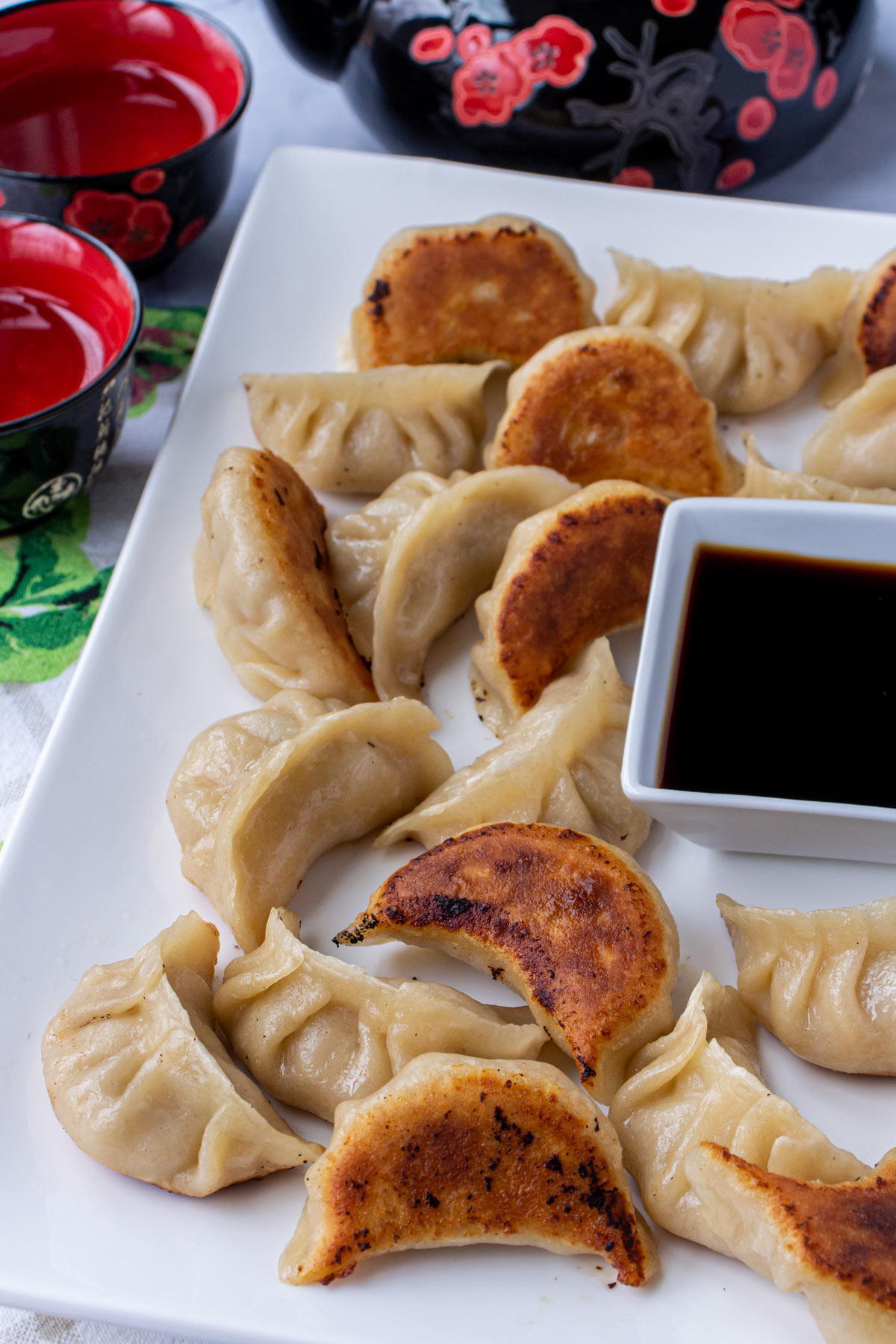
(This recipe was originally published in January 2015, but was updated with new photos and content in 2023).
The most common dumpling filling among Chinese restaurants is pork. You'll find some variation of pork dumplings (steamed or fried) on many Chinese menus. Although some may contain just pork and seasonings, it's likely that many of them also contain some cabbage and/or Chinese chives.
Pork and cabbage dumplings are perhaps the pinnacle for standard dumpling fare. Both of these key ingredients are common throughout many other Chinese recipes, so pairing them in this classic dumpling filling is perfect.
These pork and cabbage dumplings are excellent both steamed and pan-fried. You can even simply fold them into half-moons and boil them as well. They're very versatile and delicious in any form!
Ingredient notes
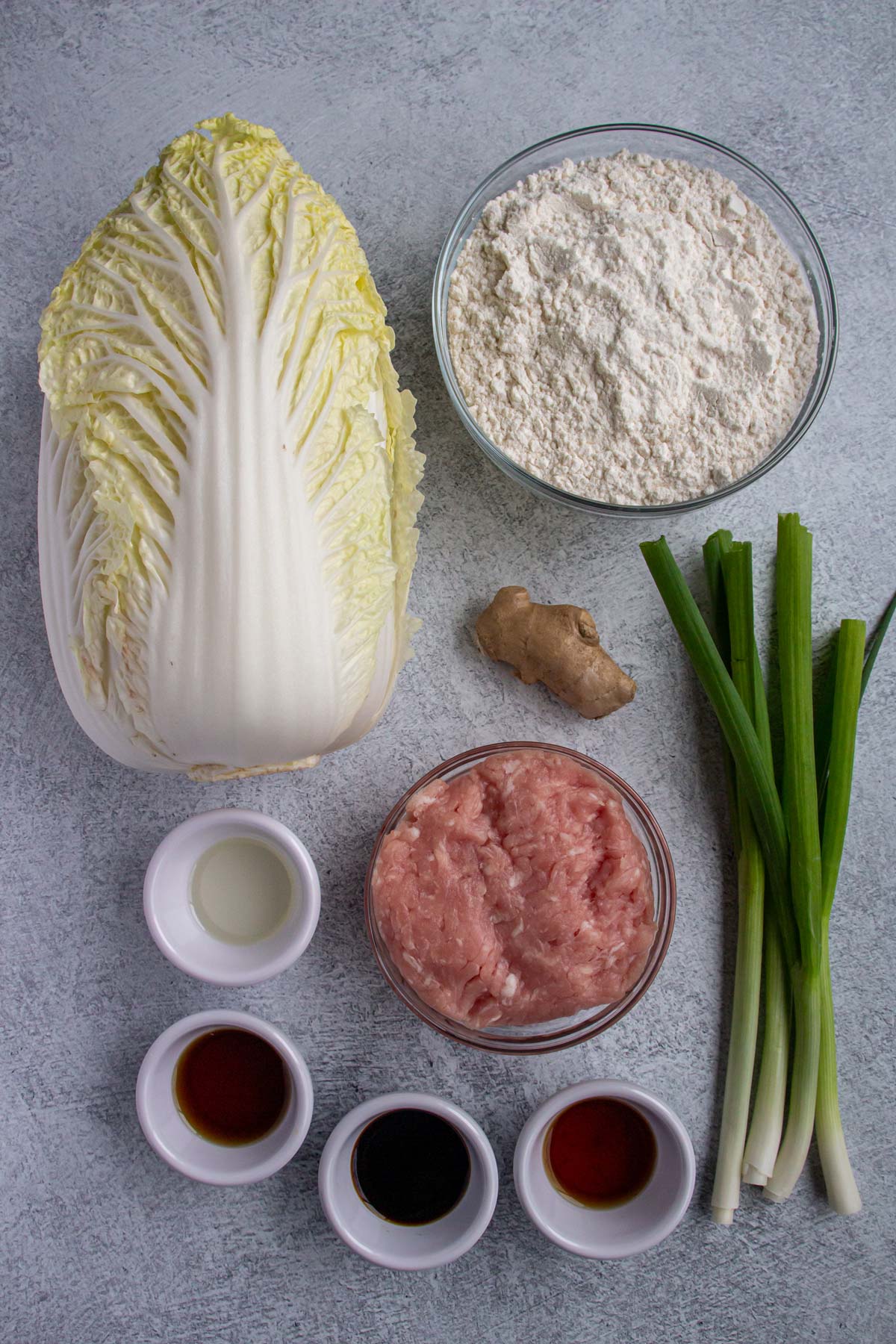
- Ground Pork: A fattier ground pork is usually preferred for pork and cabbage dumplings, however you could use any ground pork and still get great results.
- Cabbage: Finely chopped Napa cabbage or Chinese cabbage works great in this filling. If you only have green cabbage, it will still work, but Napa is preferred.
- Scallions: Use Chinese chives or scallions to add another layer of flavor to the pork and cabbage dumpling filling. Scallions will be easier to find in most grocery stores, but if you have an Asian market nearby, see if you can grab some Chinese chives to use instead.
- Shaoxing Wine: A staple in Chinese cooking, Shaoxing rice wine is available at Asian markets and online. You may substitute dry sherry if it's unavailable.
- Sesame Oil: Sesame oil is a workhorse in Chinese cuisine. Plain sesame oil is lighter in color than toasted sesame oil, which is dark brown, and much more flavorful. The packaging may not say "toasted" but you can tell the difference by the color. Plan to use toasted sesame oil for this pork and cabbage dumpling recipe.
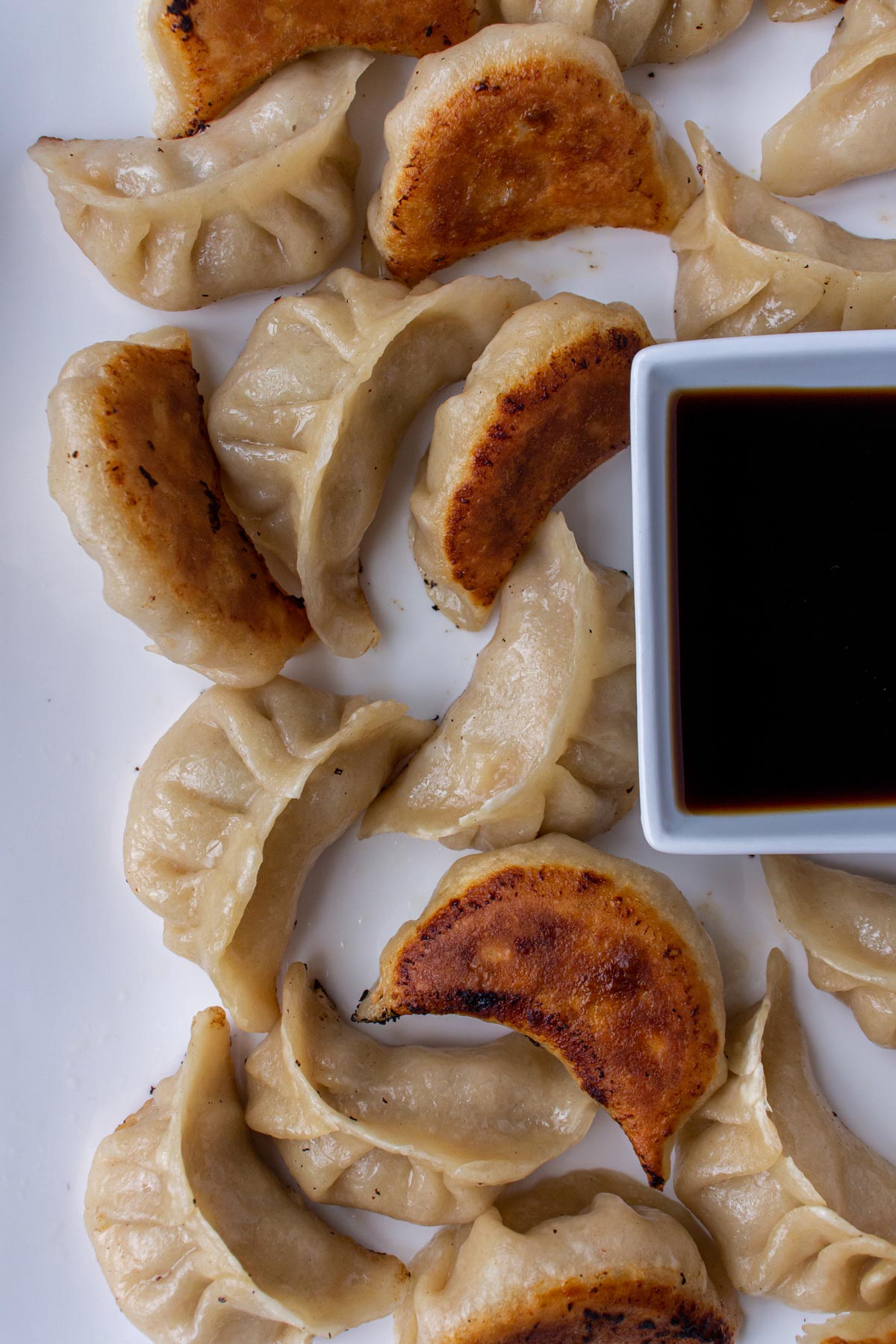
How to make the filling
Put finely chopped cabbage in a bowl and toss with salt (PHOTO 1). Set aside for about 15 minutes to draw excess moisture from cabbage. Drain, flush with water, and drain again. Squeeze the cabbage in your hands over the sink. Transfer the cabbage to a mixing bowl (PHOTO 2).
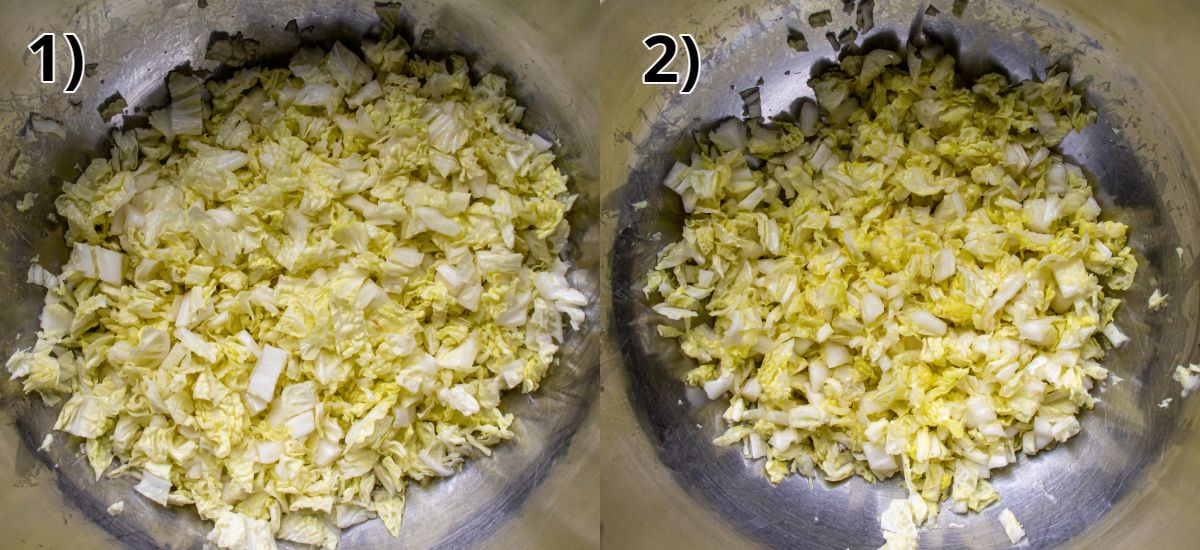
Add ginger, Chinese chives, and pork (PHOTO 3). Use a fork or spatula to stir and lightly mash the ingredients so they start coming together (PHOTO 4).
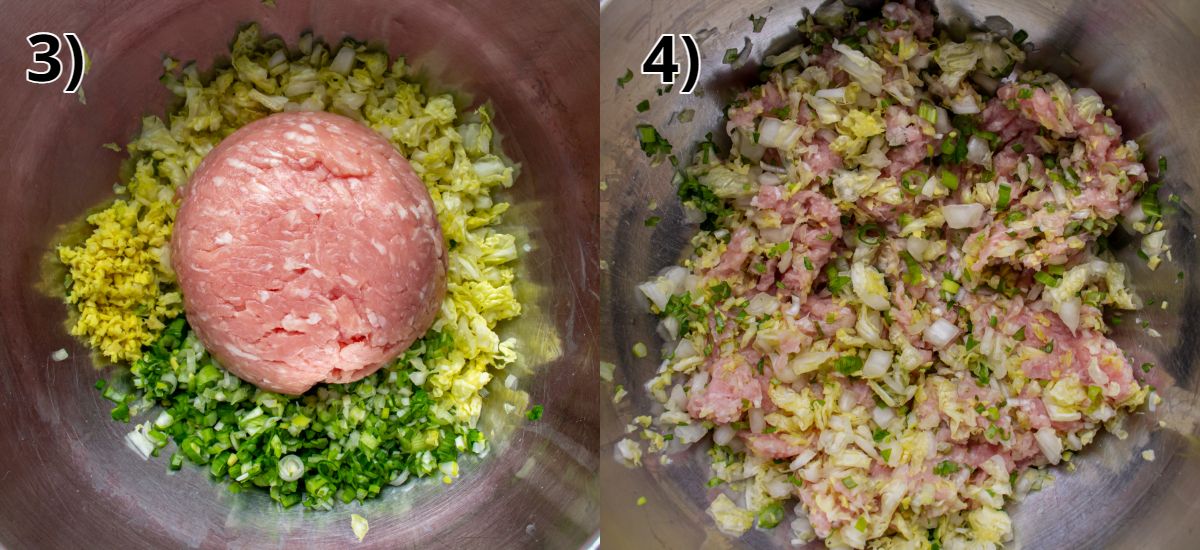
In a small bowl, stir together salt, pepper, chicken stock, soy sauce, rice wine, canola oil, and sesame oil. Pour these seasonings over the pork an cabbage mixture (PHOTO 5), then stir ingredients together. Stir to blend the ingredients into a cohesive, thick mixture (PHOTO 6).
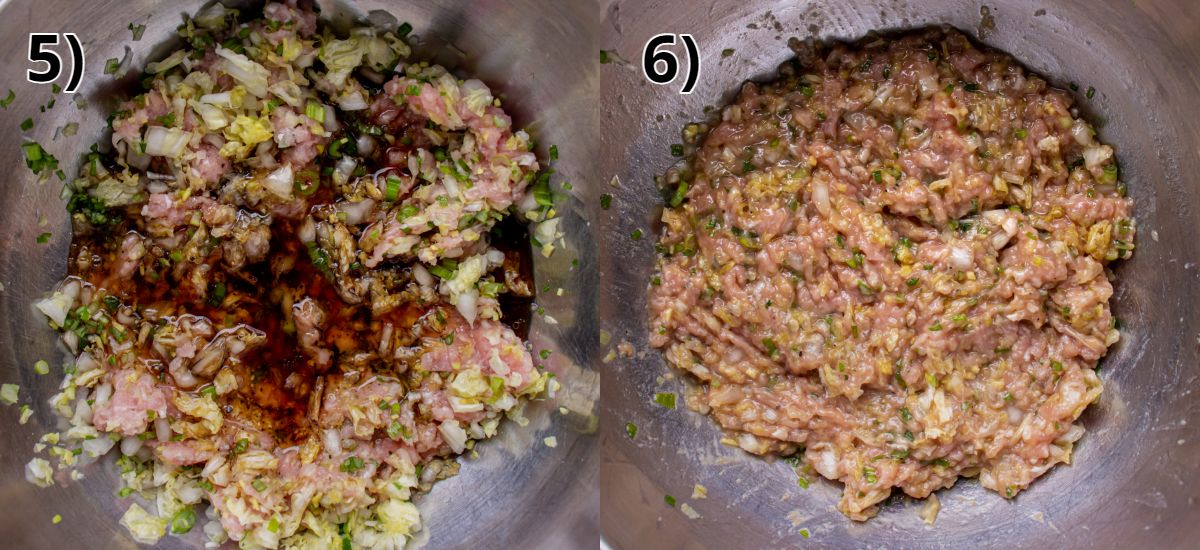
To develop the flavors, cover and set aside at room temperature for 30 minutes.
How to make the dough
Place a large mixing bowl over a damp paper towel on your work surface, to keep in place while mixing. Add flour and make a well. Use a wooden spoon to mix the flour while you add just-boiled hot water in a steady stream.
Mix together until you have a lot of lumpy bits (PHOTO 7), then knead the hot dough in the bowl until the dough comes together. Continue kneading the dough in the bowl for a couple more minutes until the dough is smooth and elastic (PHOTO 8).
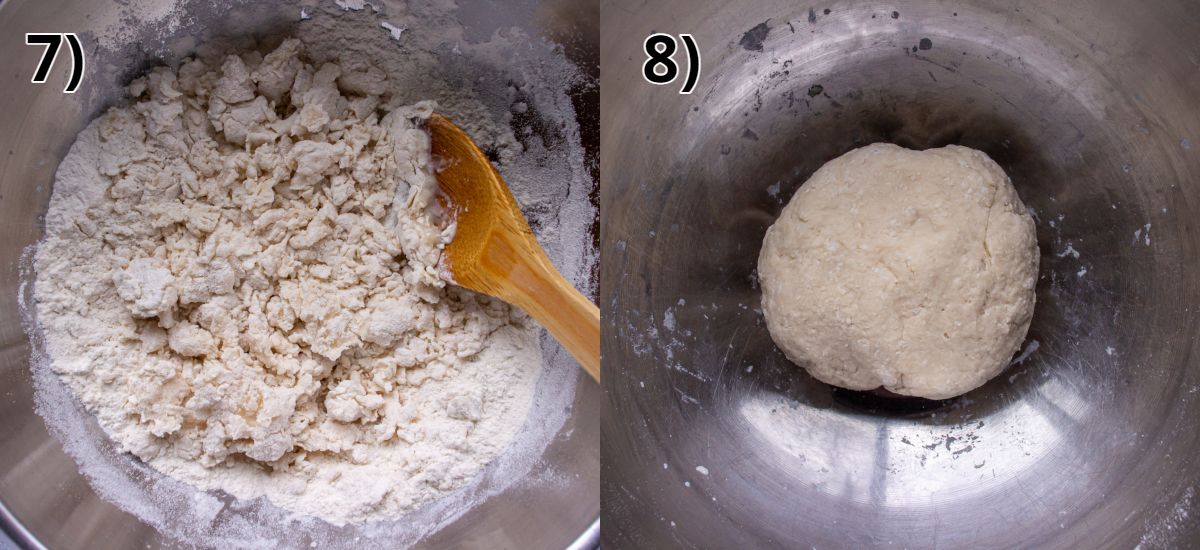
Place the dough in a zip-top bag, seal tightly, pressing out excess air, and set aside at room temperature for 15 minutes up to 2 hours. The dough will steam up the bag and soften.
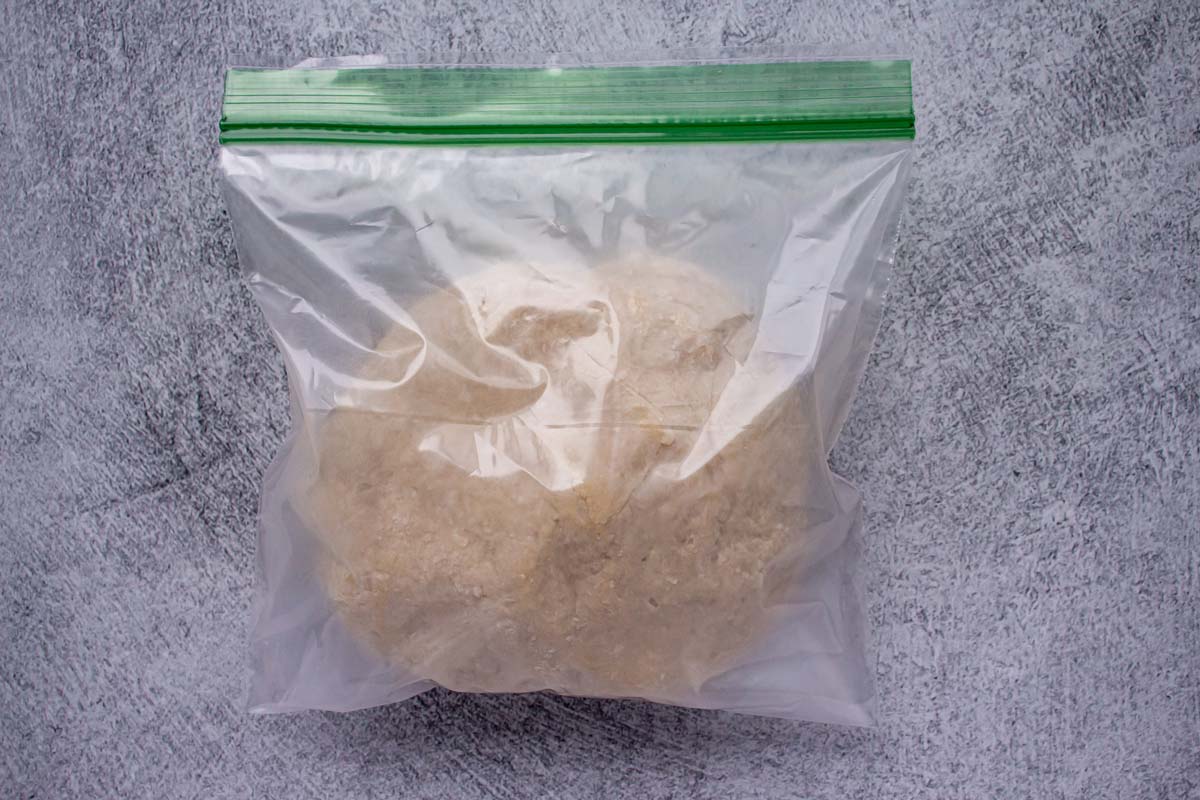
How to assemble the dumplings
Line a baking sheet with parchment paper or lightly dust with flour. Remove the dough from the bag and cut it in quarters. Put three-quarters back in the bag, squeezing out the air and sealing it closed to prevent drying.
Roll one quarter of the dough into a 1-inch-thick log and cut into 8 pieces.
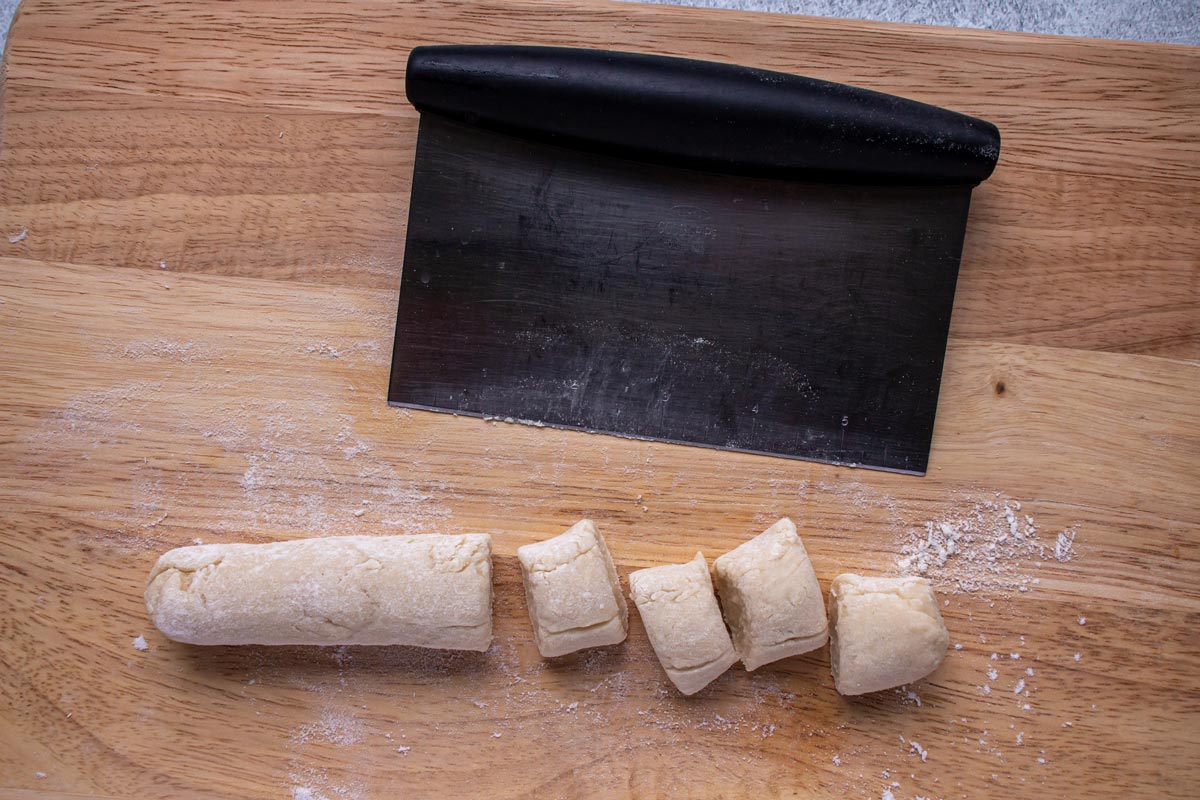
Take each piece of dough and press each cut end in flour, lightly pressing the dough to about ¼ inch thick and set aside.
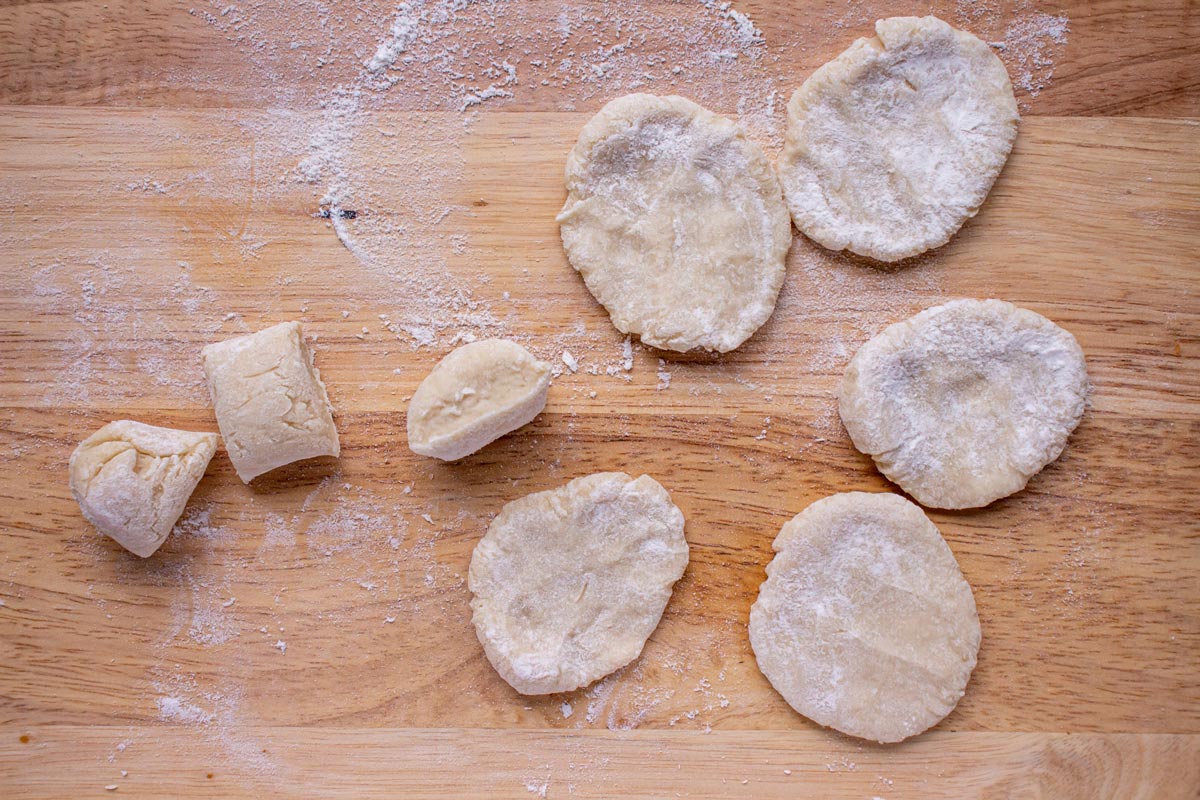
Use a dowel to lightly roll out each disc into an ⅛ inch thick circle.
To finish the wrappers, place wrappers one at a time on your work surface, and flour only if sticky. Use the rolling pin to apply pressure to the outer ½-to-¾-inch border of the wrapper. Roll the rolling pin in short downward strokes with one hand while the other hand turns the wrapper in the opposite direction.
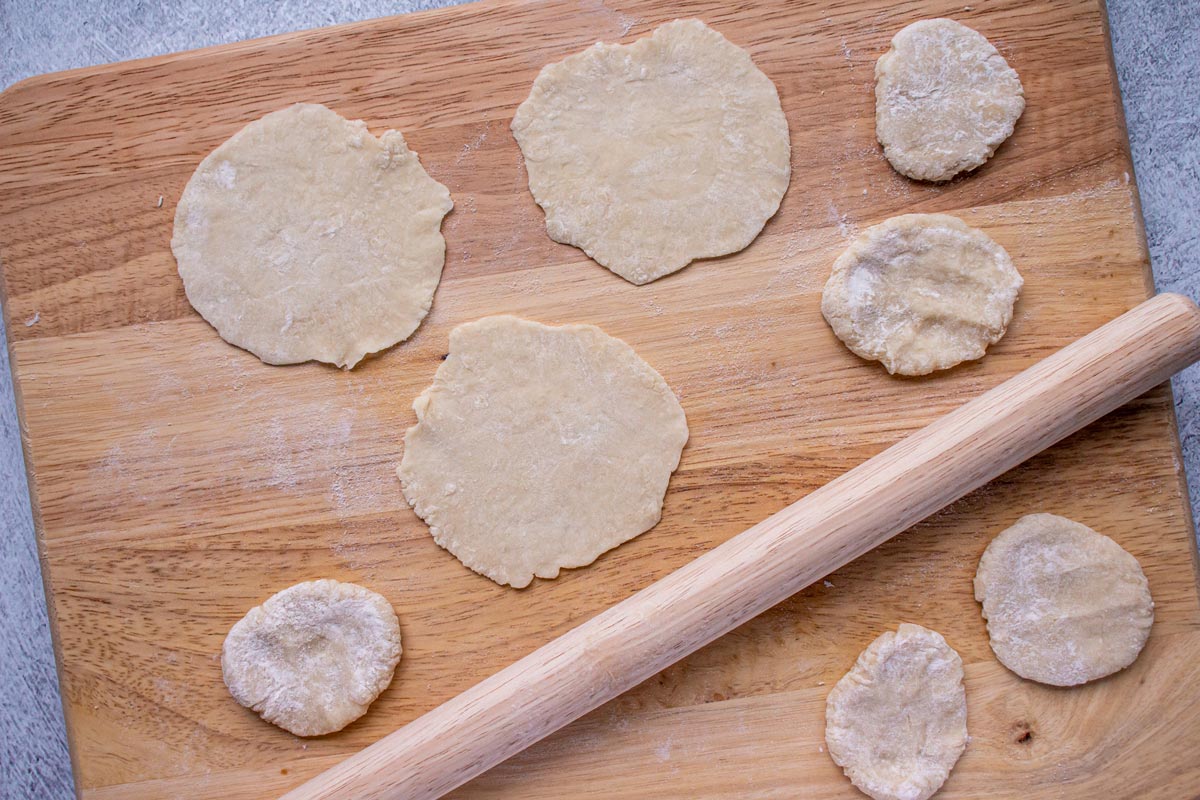
It's fine if the wrappers aren't perfect circles! When you fold and pleat the dumplings, it's easy to cover up those imperfections.
When a batch of wrappers is formed, fill them before making wrappers out of the other portions of dough.
Place about 1 tablespoon of pork and cabbage dumpling filling on the dumpling wrapper, pressing and shaping it into a flat mound and keeping a ½-to-¾-inch border on all sides. Bring up the edges to seal into a half-moon shape or pleat the edges as desired.
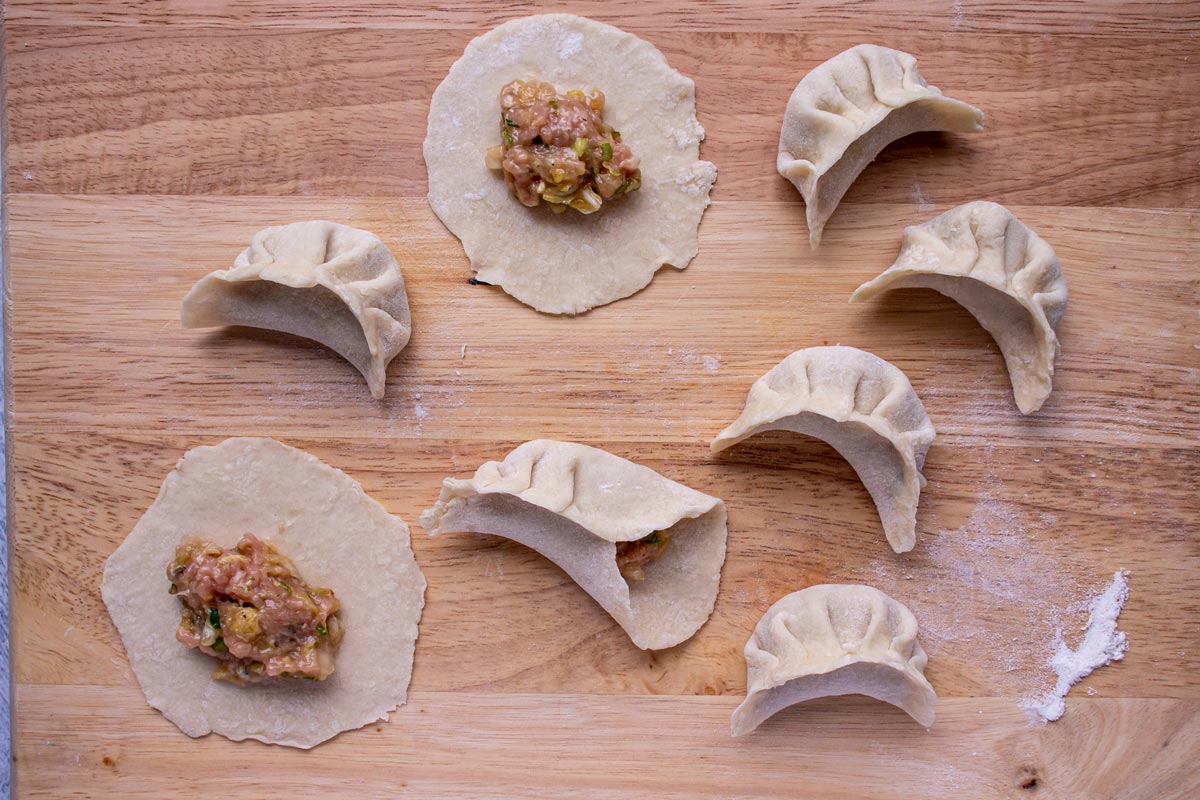
Place finished dumplings on the prepared baking sheet. Repeat with the remaining wrappers and dough. Cover finished pork and cabbage dumplings with a dry kitchen towel.
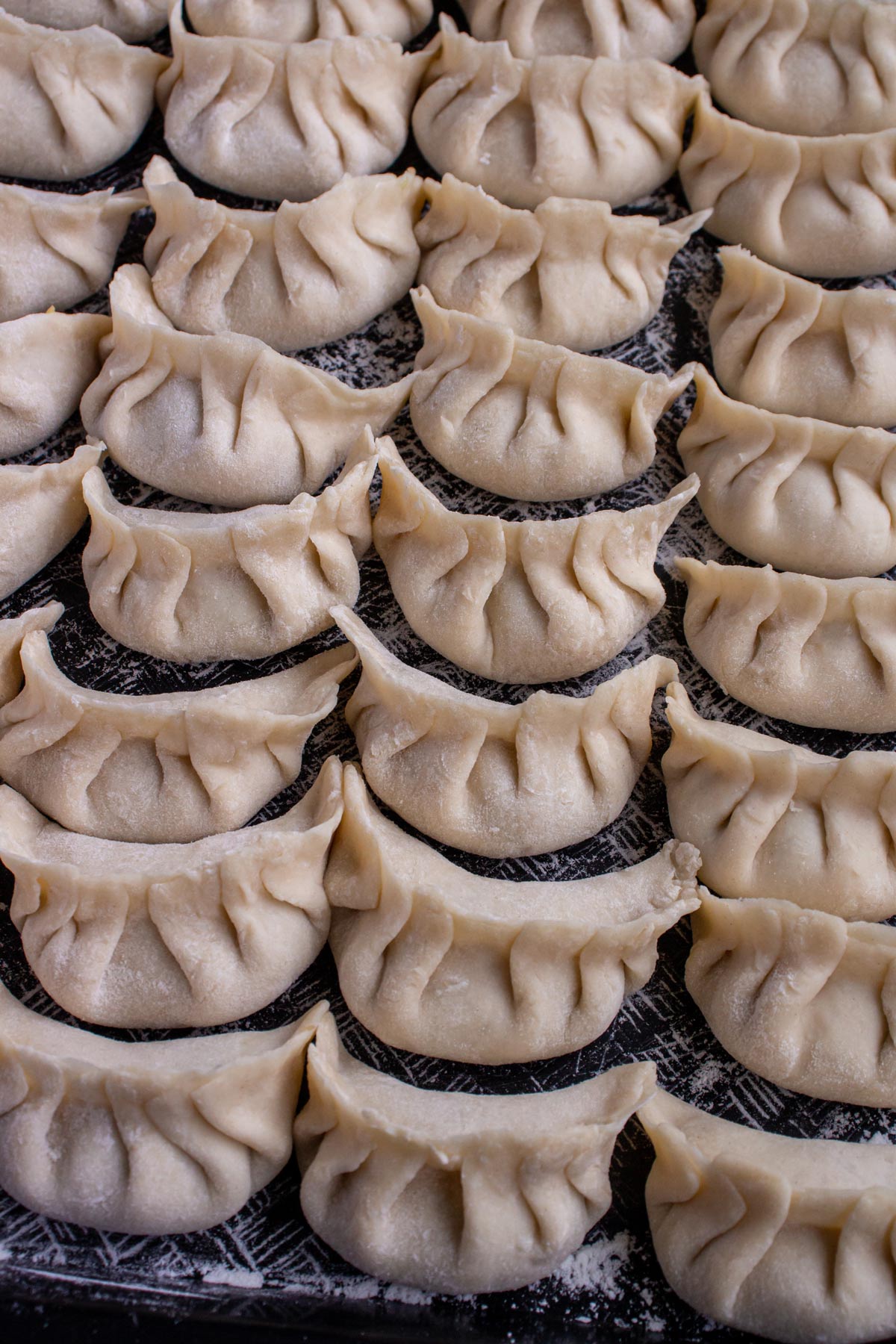
How to cook the dumplings
To boil the dumplings, half-fill a large pot with water and bring to a boil over high heat. Add half the dumplings, gently dropping each one into the water. Simmer for about 8 minutes, or until they float to the surface. Use a slotted spoon or skimmer to scoop the dumplings from the pot. Return the water to a boil and cook the remaining dumplings. When done, return the first batch to the hot water to reheat for a minute or two.
To steam the dumplings, place the dumplings into a bamboo steamer lined with a perforated parchment circle or cabbage leaves (to keep the dumplings from sticking to the steamer) steam over boiling water for for about 8 minutes, or until slightly puffed and somewhat translucent. Remove the trays and place each atop a serving plate.
To pan-fry the dumplings, heat a non-stick skillet over medium-high heat and add oil. Place the dumplings 1 at a time, sealed edges up, in a winding circle pattern. The dumplings can touch. Fry the dumplings for 1 to 2 minutes until they are golden or light brown on the bottom.
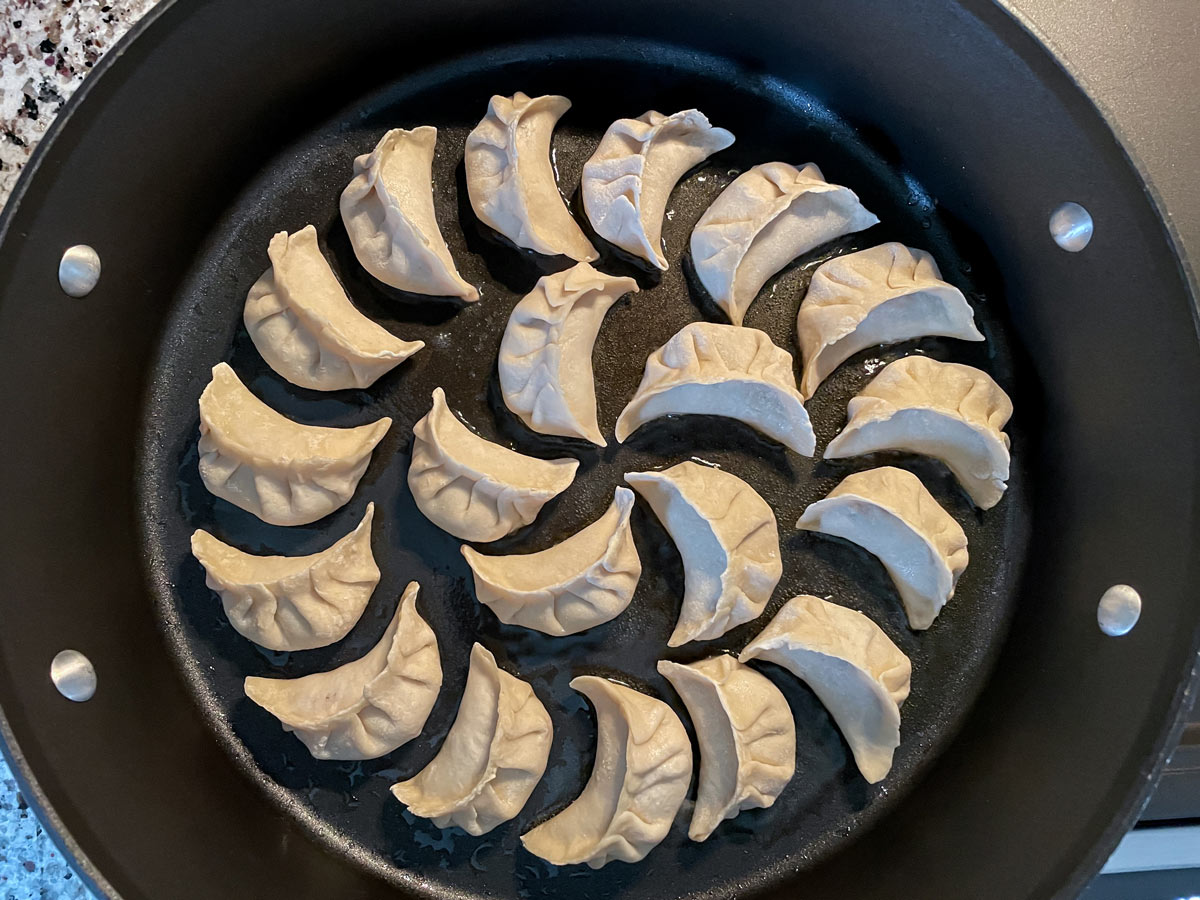
Holding the lid close to the skillet to lessen splatter, use a measuring cup to add water to a depth of roughly ¼ inch. The water will immediately sputter and boil vigorously.
Cover with a lid or aluminum foil, lower the heat to medium, and let the water bubble away for 8 to 10 minutes, until it is mostly gone. When you hear sizzling noises, remove the lid as most of the water is now gone. Let the dumplings fry for another 1 or 2 minutes, or until the bottoms are brown and crisp.
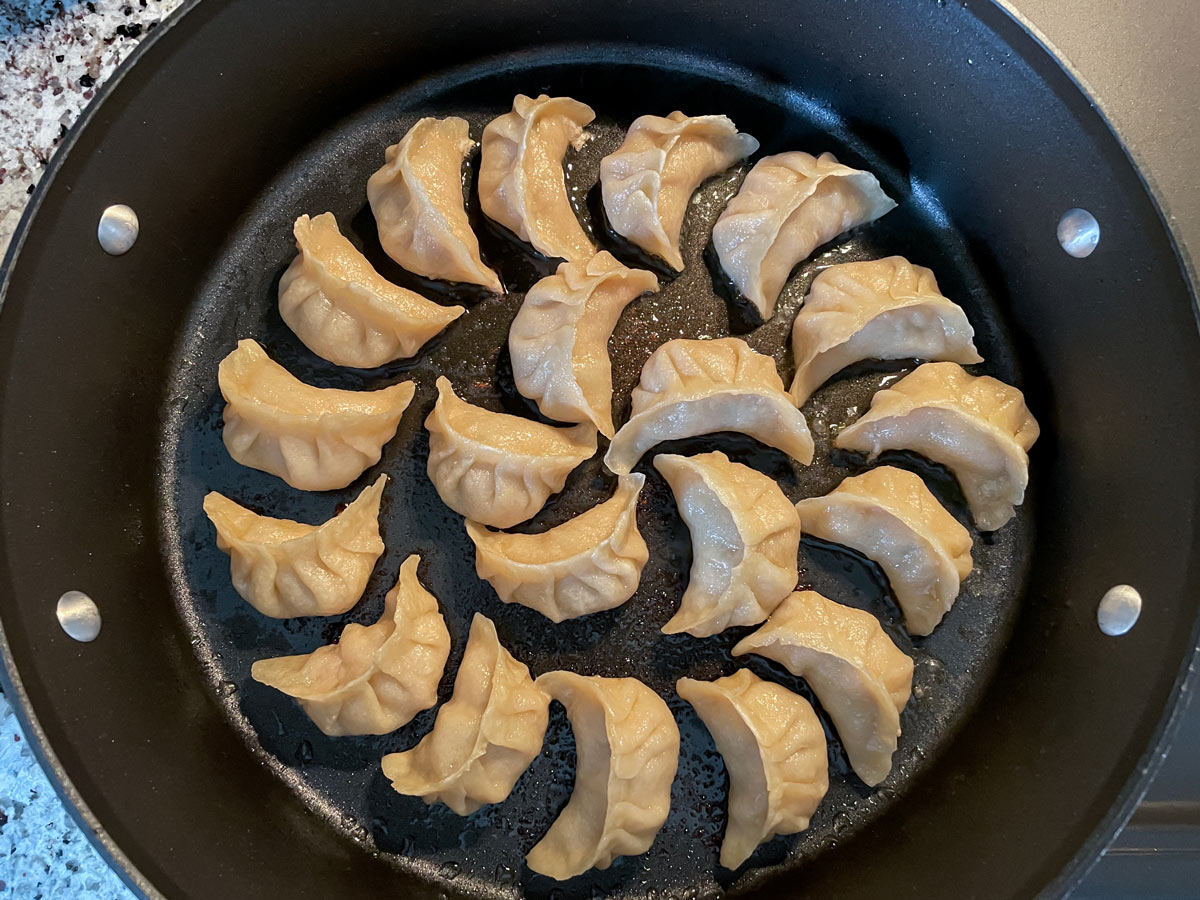
Transfer dumplings with a spatula to a serving plate. Display them with their bottoms facing up so they remain crisp.
Serve pork and cabbage dumplings with dipping sauce.
Please scroll to the bottom of the post for the full recipe (in a printable recipe card) including ingredient amounts and detailed instructions.
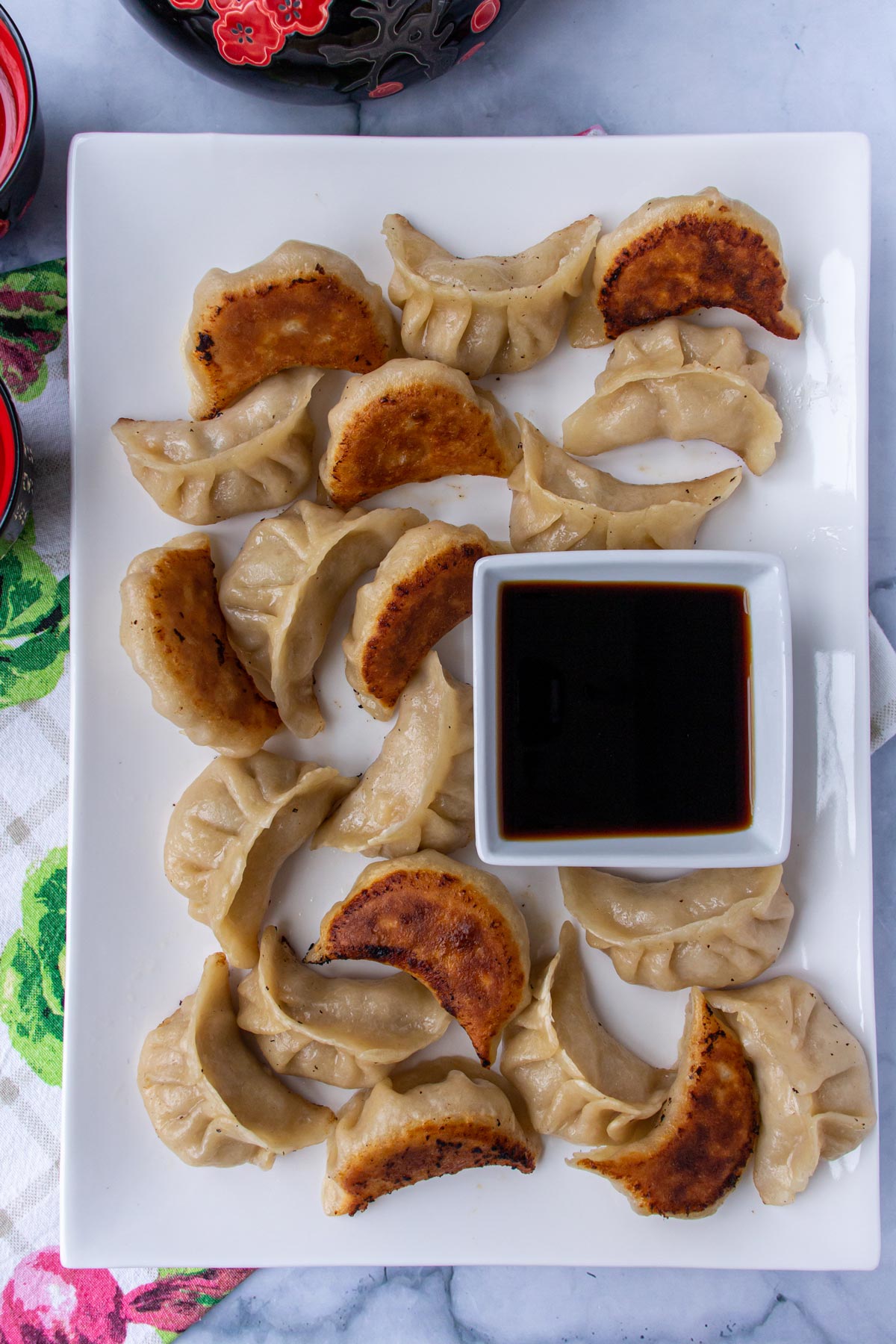
Expert tips
Make Ahead Tips:
- The filling can be prepared 1 day ahead and refrigerated. Bring it to room temperature before assembling the dumplings.
- After resting, the dough can be used right away, or refrigerated overnight and returned to room temperature before using.
- When all the dumplings are assembled, they can be covered with plastic wrap and refrigerated for several hours and can be cooked straight from the refrigerator.
Freezing Instructions: Freeze the assembled uncooked dumplings on their baking sheet until hard (about 1 hour), transfer to a zip-top freezer bag, pressing out excess air before sealing, and frozen for up to 1 month. To cook after freezing, partially thaw, using your finger to smooth over any cracks that may have formed during freezing, before cooking.
Shortcut: In a pinch, you can skip making the dough from scratch and use store-bought dumpling wrappers instead. The results will be a bit different (I prefer the texture of homemade wrappers 10/10 times), but they'll still be good! Be sure to wet the edges of the store-bought wrappers before sealing the dumplings.
Here are a couple easy ways to transform your simple white dumpling dough into colorful creations. For orange dough replace the just-boiled water with just-boiled 100% carrot juice. Meanwhile, for bright gold dough add 1 teaspoon ground turmeric into the flour before adding the water. The dough will develop its vibrant color as it sits. To make green dough follow the instructions in this Fish Dumplings recipe. Or perhaps try red dough by replacing the just-boiled water with just-boiled 100% tomato juice.
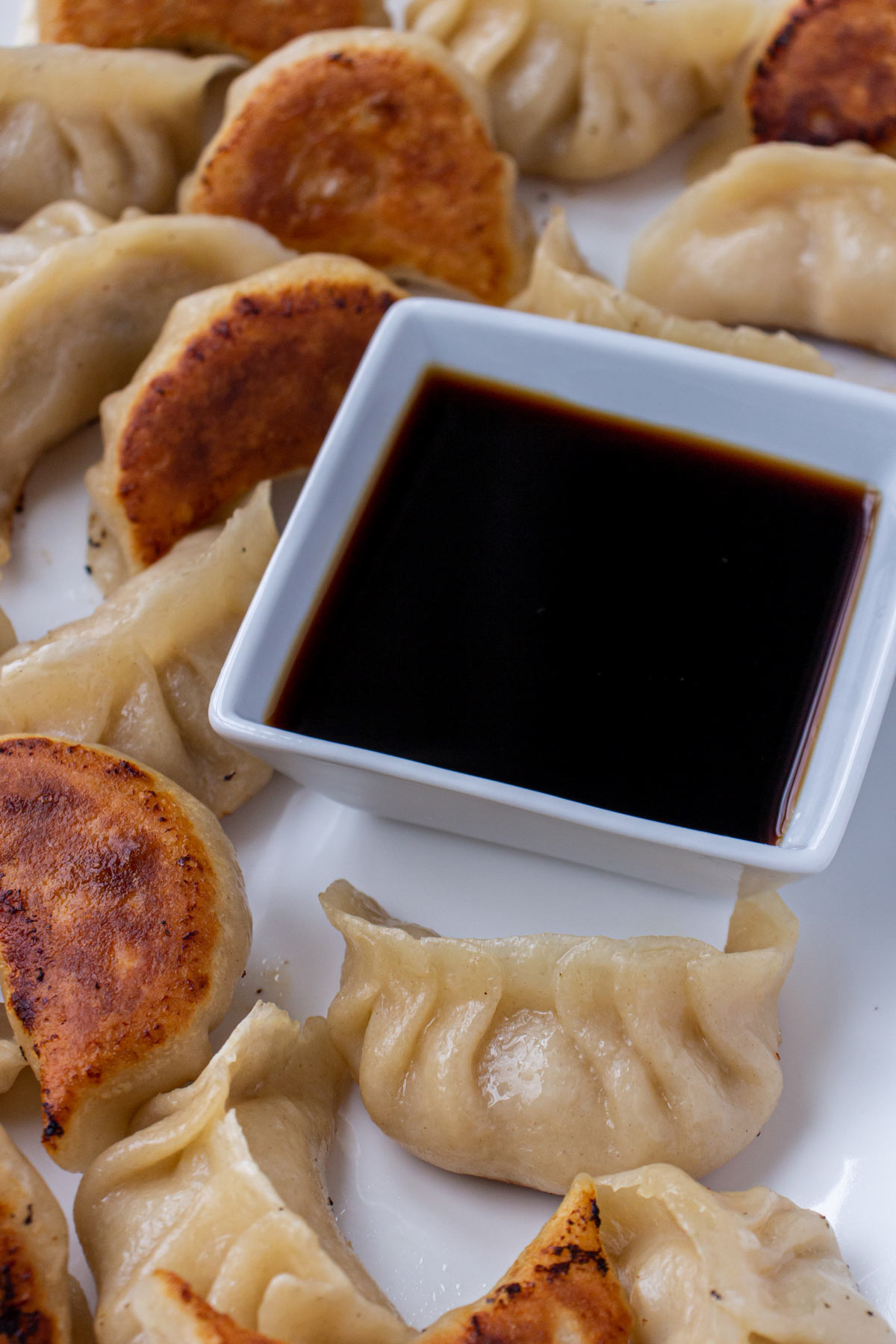
Other recipes you may like
- Pork and Shrimp Dumplings
- Pork and Chive Dumplings
- Spicy Beef Dumplings
- Chicken and Mushroom Siu Mai (Shumai)
- Three Mushroom Dumplings
- Vegetable Dumplings
- Jiu Cai Jiao (Chinese Chive Dumplings)
- Har Gow (Crystal Shrimp Dumplings)
- Khinkali (Georgian Dumplings)
Tried this recipe? Please leave a star ⭐️⭐️⭐️⭐️⭐️ rating in the recipe card below and/or a review in the comments section further down the page. You can also follow me on social media on Facebook, Instagram, and Pinterest!
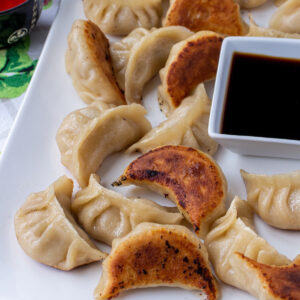
Pork and Cabbage Dumplings
Ingredients
Filling:
- 2 cups lightly packed finely chopped napa cabbage cut from whole leaves (about 4.5 ounces or 125 grams)
- ½ teaspoon plus scant ½ teaspoon kosher salt
- 1 tablespoon finely minced fresh ginger
- ¼ cup chopped Chinese chives or scallions white and green parts
- 8 ounces ground pork
- ⅛ teaspoon ground pepper
- ¼ cup chicken stock or water
- 1 ½ tablespoons light (regular) soy sauce
- 1 tablespoon Shaoxing rice wine or dry sherry
- 1 tablespoon canola oil
- 1 ½ tablespoons toasted sesame oil
Dough:
- 10 ounces (285 grams / 2 cups) all-purpose flour
- About ¾ cup just-boiled water boil water, then let it sit for a minute off the heat before measuring
Dipping Sauce:
- ⅓ cup soy sauce
- 2 ½ tablespoons unseasoned rice, Chinkiang, or balsamic vinegar
- ⅛ teaspoon sugar (optional)
- 1 tablespoon finely shredded ginger or 2 teaspoons finely minced garlic (optional)
To Cook:
- Canola or peanut oil if pan-frying
Instructions
Filling:
- Put the cabbage in a bowl and toss with the ½ teaspoon salt. Set aside for about 15 minutes to draw excess moisture from cabbage. Drain in a mesh strainer, flush with water, and drain again. Squeeze the cabbage in your hands over the sink, or put in a cotton kitchen towel and wring out the moisture over the sink.
- Transfer the cabbage to a mixing bowl and add the ginger, Chinese chives, and pork. Use a fork or spatula to stir and lightly mash the ingredients so they start coming together.
- In a small bowl, stir together the remaining scant ½ teaspoon salt, the pepper, chicken stock, soy sauce, rice wine, canola oil, and sesame oil. Pour these seasonings over the pork an cabbage mixture, then stir ingredients together. Once the pork has broken up, briskly stir to blend the ingredients into a cohesive, thick mixture. There should not be any visible large chunks of pork.
- To develop the flavors, cover and set aside at room temperature for 30 minutes. You should have about 2 cups of filling. The filling can be prepared 1 day ahead and refrigerated. Bring it to room temperature before assembling the dumplings.
Dough:
- Place a large mixing bowl over a damp paper towel on your work surface, to keep in place while mixing. Add the flour and make a well. Use a wooden spoon to mix the flour while you add the hot water in a steady stream. Mix together until you have a lot of lumpy bits, then knead the hot dough in the bowl until the dough comes together. Add water by the teaspoon if the dough does not come together.
- Continue kneading the dough in the bowl for a couple more minutes until the dough is smooth and elastic. The dough should bounce back when pressed with your finger, but leave a light impression of your finger.
- Place dough in a zip-top bag, seal tightly, pressing out excess air, and set aside at room temperature for 15 minutes up to 2 hours. The dough will steam up the bag and soften. After resting, the dough can be used right away, or refrigerated overnight and returned to room temperature before using.
Dipping Sauce:
- Combine the soy sauce, vinegar, and sugar and stir to dissolve. Taste and adjust flavors to your liking for a tart-savory balance. The sauce can be prepared several hours in advance up to this point. Right before serving, add the ginger or garlic, if using.
Assembly:
- Line a baking sheet with parchment paper or lightly dust with flour (if planning to refrigerate dumplings for several hours, use parchment and also dust with flour to prevent sticking).
- Remove the dough from the bag, turning the bag inside out if the dough is sticky. Put the dough on a lightly floured surface and cut it in quarters. Put three-quarters back in the bag, squeezing out the air and sealing it closed to prevent drying.
- Roll one quarter of the dough into a 1-inch-thick log and cut into 8 pieces (cut in half, then cut each half in half, and so on to create pieces that are even in size. The tapered end pieces should be cut slightly larger).
- Take each piece of dough and press each cut end in flour, lightly pressing the dough to about ¼ inch thick and set aside.
- Use a dowel (which is a good lightweight rolling pin alternative for fast and flexible dumpling making) to lightly roll out each disc into an ⅛ inch thick circle.
- To finish the wrappers, place wrappers one at a time on your work surface, and flour only if sticky. Use the rolling pin to apply pressure to the outer ½-to-¾-inch border of the wrapper. Roll the rolling pin in short downward strokes with one hand while the other hand turns the wrapper in the opposite direction. Aim for wrappers that are about 3 ¼ inches in diameter. When a batch of wrappers is formed, fill them before making wrappers out of the other portions of dough.
- Hold a wrapper in a slightly cupped hand and scoop about 1 tablespoon of filling on the wrapper, pressing and shaping it into a flat mound and keeping a ½-to-¾-inch border on all sides. Bring up the edges to seal into a half-moon shape or pleat the edges as desired.
- Place finished dumplings on the prepared baking sheet. Repeat with the remaining wrappers and dough, spacing out dumplings about ½ inch apart. Keep the finished dumplings covered with a dry kitchen towel.
- When all the dumplings are assembled, they can be covered with plastic wrap and refrigerated for several hours and can be cooked straight from the refrigerator.
Cooking:
- To boil the dumplings, half-fill a large pot with water and bring to a boil over high heat (I like to salt the water, but it’s not necessary). Add half the dumplings, gently dropping each one into the water. Nudge them apart with a wooden spoon to keep them from sticking together or to the bottom of the pot. Return the water to a simmer and then lower the heat to maintain a simmer and gently cook the dumplings for about 8 minutes, or until they float to the surface, look glossy, and are puffed up and a tad translucent. Use a slotted spoon or skimmer to scoop the dumplings from the pot, a few at a time, pausing the spoon’s motion over the pot to allow excess water to drip back down before putting the dumplings on a serving plate. Cover the plate with a large inverted bowl to keep the dumplings warm. Return the water to a boil and cook the remaining dumplings. When done, return the first batch to the hot water to reheat for a minute or two. There is no need to reboil.
- To steam the dumplings, place the dumplings into a bamboo steamer lined with a perforated parchment circle or cabbage leaves (to keep the dumplings from sticking to the steamer) steam over boiling water for for about 8 minutes, or until slightly puffed and somewhat translucent. Remove the trays and place each atop a serving plate.
- To pan-fry the dumplings, use a medium or large nonstick skillet (or cook two batches at the same time using two pans). Heat the skillet over medium-high heat and add 1 ½ tablespoons oil for a medium skillet and 2 tablespoons for a large one. Place the dumplings 1 at a time, sealed edges up, in a winding circle pattern. The dumplings can touch. Medium skillets will generally fit 12 to 14 dumplings, large skillets will fit 16 to 18 dumplings. Fry the dumplings for 1 to 2 minutes until they are golden or light brown on the bottom.
- Holding the lid close to the skillet to lessen splatter, use a measuring cup to add water to a depth of roughly ¼ inch (about ⅓ cup water). The water will immediately sputter and boil vigorously. Cover with a lid or aluminum foil, lower the heat to medium, and let the water bubble away for 8 to 10 minutes, until it is mostly gone. When you hear sizzling noises, remove the lid as most of the water is now gone. Let the dumplings fry for another 1 or 2 minutes, or until the bottoms are brown and crisp. Turn off the heat and wait until the sizzling stops before using a spatula to transfer dumplings to a serving plate. Display them with their bottoms facing up so they remain crisp.
- Serve with the dipping sauce in a communal bowl or in individual dipping sauce dishes.
Notes
- Freeze the assembled uncooked dumplings on their baking sheet until hard (about 1 hour), transfer to a zip-top freezer bag, pressing out excess air before sealing, and frozen for up to 1 month. To cook after freezing, partially thaw, using your finger to smooth over any cracks that may have formed during freezing, before cooking.
- Here are a couple easy ways to transform your simple white dumpling dough into colorful creations. For orange dough replace the just-boiled water with just-boiled 100% carrot juice. Meanwhile, for bright gold dough add 1 teaspoon ground turmeric into the flour before adding the water. The dough will develop its vibrant color as it sits. To make green dough follow the instructions in this Fish Dumplings recipe. Or perhaps try red dough by replacing the just-boiled water with just-boiled 100% tomato juice.
- Adapted from Asian Dumplings
Nutrition
*All nutritional information is based on third-party calculations and should be considered estimates. Actual nutritional content will vary with brands used, measuring methods, portion sizes and more.*




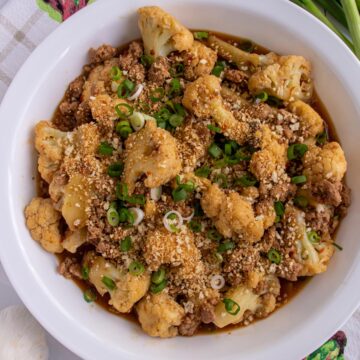
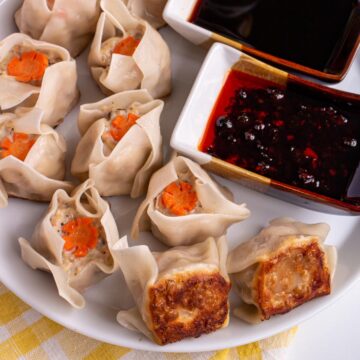
Comments
No Comments